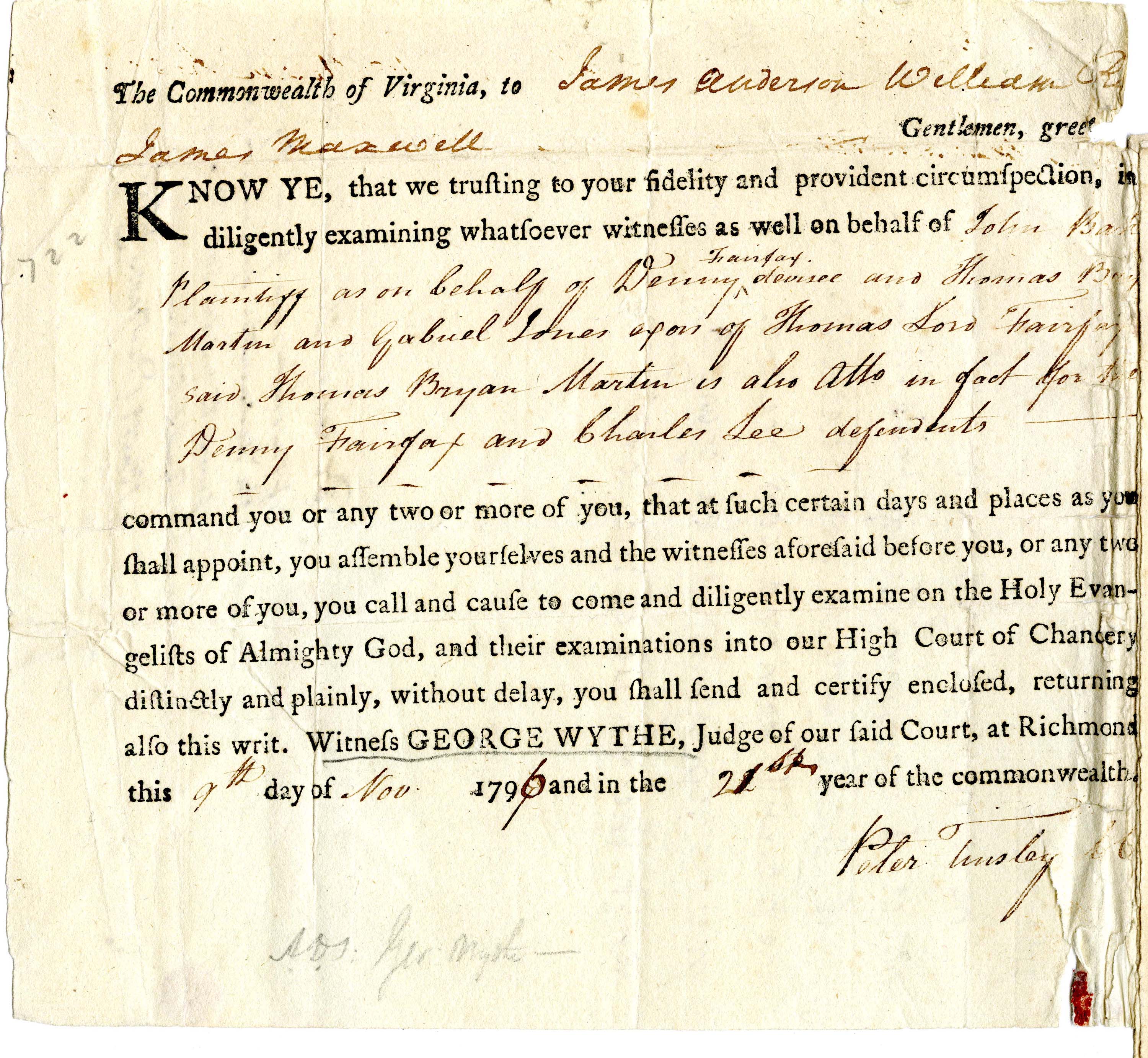Difference between revisions of "Peter Tinsley"
m (→Clerk of the High Court of Chancery) |
m (→Clerk of the High Court of Chancery) |
||
| Line 10: | Line 10: | ||
==Clerk of the High Court of Chancery== | ==Clerk of the High Court of Chancery== | ||
| − | According to his obituary, Tinsley was Clerk of the High Court of Chancery beginning while Wythe was the sole Chancellor (sometime after 1788), and continued as clerk after the re-division of the court in 1802, until his death in 1810,<ref>''Virginia Patriot.''</ref> when he was replaced by [wikipedia:William Waller Hening|W.W. Hening]. As Wythe's clerk for more than a decade, Peter Tinsley had a unique perspective into the Chancellor's life and work. Tinsley's "[[Legal Form Book of Peter Tinsley|form book]]" from this time, survives. In this manuscript, Tinsley compiled various sample documents for the court's use, sparing them from having to reinvent the wheel each time it needed to issue a document. Without the clerk and his book of forms, the court could not follow proper procedure, or maintain efficient function. | + | According to his obituary, Tinsley was Clerk of the High Court of Chancery beginning while Wythe was the sole Chancellor (sometime after 1788), and continued as clerk after the re-division of the court in 1802, until his death in 1810,<ref>''Virginia Patriot.''</ref> when he was replaced by [[wikipedia:William Waller Hening|W.W. Hening]]. As Wythe's clerk for more than a decade, Peter Tinsley had a unique perspective into the Chancellor's life and work. Tinsley's "[[Legal Form Book of Peter Tinsley|form book]]" from this time, survives. In this manuscript, Tinsley compiled various sample documents for the court's use, sparing them from having to reinvent the wheel each time it needed to issue a document. Without the clerk and his book of forms, the court could not follow proper procedure, or maintain efficient function. |
Virginia's High Court of Chancery also made use of [[:File:TinsleyCommission9November1796.jpg|pre-printed forms]], which the clerk could issue for routine tasks by simply filling in the blanks. | Virginia's High Court of Chancery also made use of [[:File:TinsleyCommission9November1796.jpg|pre-printed forms]], which the clerk could issue for routine tasks by simply filling in the blanks. | ||
Revision as of 10:03, 21 April 2018

Peter Tinsley (1750s – July 21, 1810) was a Virginia attorney, and Clerk of the Court for the High Court of Chancery in Richmond during and after George Wythe's tenure as chancery court judge.
Contents
Life
Although the date of his birth is unknown, Peter was the son of Thomas and Agnes Tinsley, who were married in 1754. Peter had at least four siblings, the most famous of which was Colonel Thomas Tinsley (1755-1822).
Peter Tinsley lived in Richmond on Sixth Street, near Clay Street, just a few blocks from the homes of George Wythe and John Marshall, near the Virginia Capital building, where the state courts were located.[1] He married Miss Maria Brown, daughter of John Brown (one of Wythe's former students), on July 12, 1803.[2] They had four children, the second of whom they named George Wythe Tinsley.[3] Unfortunately, Tinsley's children were still young when, "after a short and severe illness," he died on Saturday, July 10, 1810.[4]
Clerk of the High Court of Chancery
According to his obituary, Tinsley was Clerk of the High Court of Chancery beginning while Wythe was the sole Chancellor (sometime after 1788), and continued as clerk after the re-division of the court in 1802, until his death in 1810,[5] when he was replaced by W.W. Hening. As Wythe's clerk for more than a decade, Peter Tinsley had a unique perspective into the Chancellor's life and work. Tinsley's "form book" from this time, survives. In this manuscript, Tinsley compiled various sample documents for the court's use, sparing them from having to reinvent the wheel each time it needed to issue a document. Without the clerk and his book of forms, the court could not follow proper procedure, or maintain efficient function.
Virginia's High Court of Chancery also made use of pre-printed forms, which the clerk could issue for routine tasks by simply filling in the blanks.
Thomas Tinsley
Peter's brother Thomas served as an officer in the Revolutionary War, and for "eight consecutive one-year terms as a Hanover County delegate to Virginia's General Assembly."[6] Thomas was the builder of Totomoi, an historic plantation in Hanover County, Virginia, north of Richmond.[7] Thomas was likely the eldest surviving male Tinsley sibling, earning him the bulk of any family inheritance. Thomas' path crossed with his brother's work more than once.
It was Thomas Tinsley who recommended a fourteen-year-old Henry Clay for a job in Peter's office, in or around 1793, bringing Clay within reach of Wythe's influence.[8] Although Wythe had apparently set aside teaching and dedicated himself to his work as a jurist, Wythe made an exception for Clay and "took the young man under his wing" when he recognized Clay's potential.[9] So, through his brother Thomas, Peter Tinsley forms a significant link in the chain of Clay's career.
Thomas was a Captain in the army when he was "transferred to the southern frontier," and apparently left without paying "a debt to a freedwoman in Wythe's household," cook and housekeeper, Lydia Broadnax. Wythe intervened, writing to "his friend," President Jefferson, to encourage Captain Tinsley to resolve the matter. Wythe needn't have bothered the President with the matter; Peter Tinsley stepped up in his brother's defense and paid the debt, and asked Wythe write to to Jefferson to clear Thomas' reputation.
Obituary, The Virginia Patriot (Richmond, VA), 24 July 1810
Page 3

See also
References
External links
- F.L. Preston, "Tinsley" genealogy.